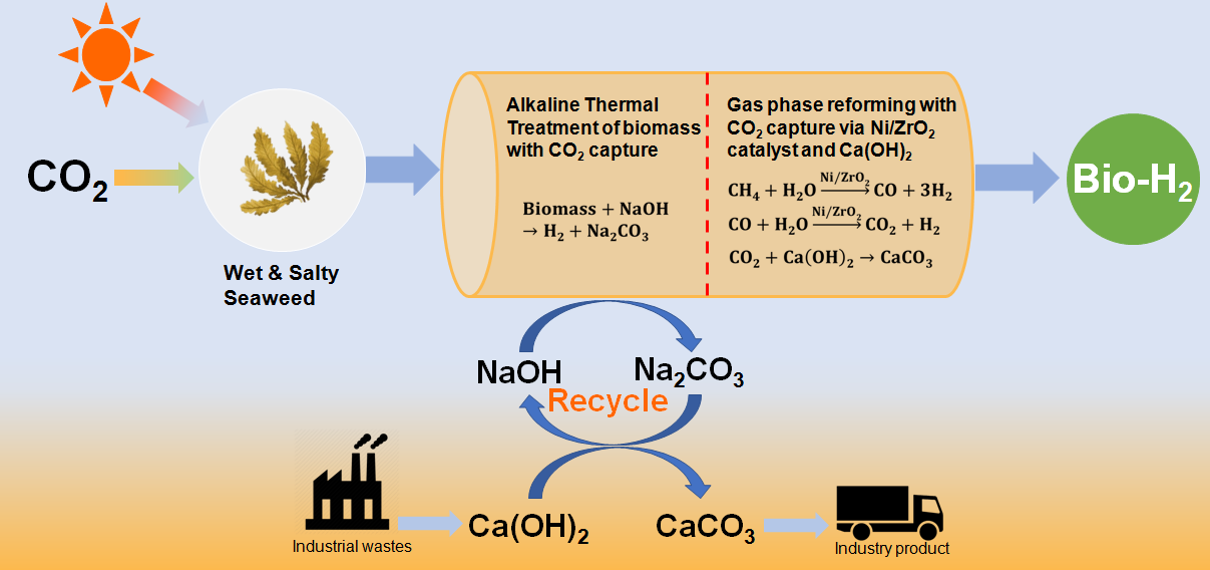Research
Research Area
Hydrogen Production from Biomass
- 작성일 : 2024-12-11
- 작성자 : 김우재교수님연구실 관리자
Environmental Catalyst (청정수소생산 촉매개발)
우리 연구실은 기존의 화석 연료에 비해 친환경적이며, 연료전지 자동차를 위해 수요가 급증하고 있는 수소 에너지를 화석 자원이 아닌 (1) 재생자원으로 부터 생산하고, (2) 공정 중에 이산화탄소를 전혀 배출하지 않는 (3) 새로운 수소생산기술 개발에 대한 연구를 수행하고 있습니다. 특히, 재생자원으로서 해조류를 포함한 다양한 바이오매스를 이용하고, 친환경 반응메카니즘으로 알칼리 열처리반응 (Alkali Thermal Treatment)을 적용하며, 이를 바탕으로 고순도 수소를 생산할 수 있는 새로운 수소전환기술을 개발, 이를 연료전지 자동차에 직접 적용하는 연구를 수행하고 있습니다. 최근에는 폐플라스틱을 수소로 전환하는 공정을 개발하고 있습니다
Given the rapid development of the global economy and ever-increasing population, the world’s energy demand will increase by 30% by 2040 according to the International Energy Agency (IEA). Global CO2 emissions from energy use are expected to increase up to 35.7 GT per year, which is far from the necessary level required to avoid severe climate change. Thus, further use of renewable low-carbon and carbon-neutral energy sources (e.g., solar photovoltaic, wind, hydropower, and biomass) is urgently needed. H2 has a high energy density and is the only carbon-free energy carrier compared to conventional fuels. With the emerging market of fuel cell vehicles, H2 is also increasing in demand. At present, it is mainly produced from fossil sources leading to inevitable CO2 emissions. That is, with current thermochemical methods to generate H2 including gasification and steam reforming of coal and natural gas, anthropogenic CO2 emission is inevitable. However, a truly transformative scheme of H2 production should be renewable and carbon-neutral. Biomass is a carbon-neutral energy source, absorbing CO2 from atmosphere through photosynthesis, and can be even carbon-negative when combined with carbon capture and storage. If biomass is used as a source of H2, the process can be considered carbon-neutral. Particularly, seaweed is a unique aquatic biomass that does not compete for land or fresh water. Its use as an energy source is not well studied and its high moisture and salt contents will be challenging if used in conventional biomass conversion processes. Unfortunately, reaction pathways to thermochemically convert salty and wet biomass into H2 are limited.
To address these challenges, we developed a novel catalytic alkaline thermal treatment (ATT) of seaweed, which can innovatively produce high purity H2 from wet and salty biomass feedstock with substantially suppressed CO2 formation, making the overall biomass conversion not only carbon-neutral but also potentially carbon-negative. We recently demonstrated that high-purity 1.57 L H2 is produced from 1 g of brown seaweed with a conversion as high as 71%, which is considerably greater than those reported in the literature. ATT can simplify reaction pathways to produce only H2, while conventional gasification reaction generates various gas products, including CO, CO2, and various hydrocarbons. The ATT also captures CO2 as solid carbonates (therefore, doesn’t produce any green house gas) as well as fragments the biomass to produce high purity H2, working together with reforming catalysts. By in-situ capturing CO2 and regenerating the hydroxide via mineral carbonation, this bio-H2 production technology has shown a great BioEnergy with Carbon Capture and Storage (BECCS) potential. This study provides insights into the future deployment of carbon-negative H2 production from unconventional biomass sources such as seaweed, food waste, and algae, which are often high in water and salt contents.

